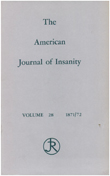Diagnostic stability in adolescents followed up 2 years after hospitalization
Abstract
OBJECTIVE: The authors examined the stability of DSM-III-R disorders and groups of disorders in adolescent inpatients followed up 2 years after hospitalization. METHOD: Seventy hospitalized adolescents were reliably assessed by using structured diagnostic interviews for DSM-III- R disorders. Two years later the subjects were independently assessed with the same interviews. Diagnostic stability was measured by determining both the percentage of persisting cases and the kappa statistic. RESULTS: Internalizing disorders had the highest percentage of persisting cases (59%) but an insignificant kappa due to many new cases at follow-up. Externalizing disorders had a lower percentage of stable cases (39%) but a significant kappa because of fewer new cases. Substance use disorders were fairly stable (53%) and had a significant kappa, indicating that this may be the most stable group of disorders in adolescents. Personality disorder clusters were relatively unstable, especially clusters A and C. CONCLUSIONS: Diagnostic stability in these hospitalized adolescents was less than that reported for adults. This may indicate that DSM-III-R diagnoses in adolescents have poor construct validity, but it may also reflect the different paths for development of psychopathology during adolescence. For axis I, externalizing disorders appear most specific to adolescence, with some persistence but decreasing incidence over time. Existing cases of internalizing disorders tend to be even more persistent, but the high incidence of new cases during adolescence contributes to lower overall stability. Substance use disorders appear to be most stable, and personality disorders appear to be least stable, in adolescents.
Access content
To read the fulltext, please use one of the options below to sign in or purchase access.- Personal login
- Institutional Login
- Sign in via OpenAthens
- Register for access
-
Please login/register if you wish to pair your device and check access availability.
Not a subscriber?
PsychiatryOnline subscription options offer access to the DSM-5 library, books, journals, CME, and patient resources. This all-in-one virtual library provides psychiatrists and mental health professionals with key resources for diagnosis, treatment, research, and professional development.
Need more help? PsychiatryOnline Customer Service may be reached by emailing [email protected] or by calling 800-368-5777 (in the U.S.) or 703-907-7322 (outside the U.S.).



